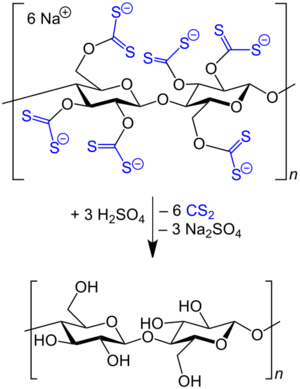Chemistry:Viscose
Viscose is a type of rayon fiber that is made from natural sources such as wood and agricultural products that are regenerated as cellulose fiber. The molecular structure of natural cellulose is preserved in the process. The many types and grades of viscose fibers can imitate the feel and texture of natural fibers such as silk, wool, cotton, and linen. The types that resemble silk are often called artificial silk. The fibre is used to make textiles for clothing and other purposes.[1]
Rayon is manufactured from naturally occurring cellulose; hence, it is not considered to be synthetic. Technically, the term synthetic fiber is reserved for fully synthetic fibers made from synthetic polymers. In manufacturing terms, rayon is classified as "a fiber formed by regenerating natural materials into a usable form"[citation needed]. Specific types of rayon include viscose, modal and lyocell, each of which differs in the manufacturing process and the properties of the finished product.
Viscose can mean:
- A viscous solution of cellulose
- A synonym of rayon
- A specific term for viscose rayon — rayon made using the viscose (cellulose xanthate) process
The viscose fiber is made from dissolving wood pulp and regenerating it in the form of fibers. Pulp made from wood or bamboo is the most common raw material for making viscose. Viscose process dissolves cellulose pulp with aqueous sodium hydroxide in the presence of carbon disulfide. This viscous solution bears the name viscose. The cellulose solution is used to spin the viscose or the rayon fiber. Viscose rayon fiber is a soft fiber commonly used in dresses, linings, shirts, shorts, coats, jackets, and other outerwear. It is also used in industrial yarns, tyre cord, upholstery and carpets, to make disposable wipes, cleaning cloths and in the casting of cellophane.
Manufacture

Viscose rayon is a fiber of regenerated cellulose; its molecular structure is that of cellulose in cotton and many other plants such as soy, bamboo, and sugar cane. Cellulose is a linear polymer of β-D-glucose units with the empirical formula (C6H10O5)n.[3] To prepare viscose, dissolving pulp is treated with aqueous sodium hydroxide (typically 16-19% w/w) to form "alkali cellulose", which has the approximate formula [C6H9O4-ONa]n. This is allowed to depolymerize to an extent. The rate of depolymerization (ripening or maturing) depends on temperature and is affected by the presence of various inorganic additives, such as metal oxides and hydroxides. Air also affects the ripening process since oxygen causes depolymerization. The alkali cellulose is then treated with carbon disulfide to form sodium cellulose xanthate.[4]
- [C6H9O4-ONa]n + nCS2 → [C6H9O4-OCS2Na]n
The higher the ratio of cellulose to combined sulfur, the lower the solubility of the cellulose xanthate. The xanthate is dissolved in aqueous sodium hydroxide (typically 2-5% w/w). The solution's viscosity is determined by the extent of depolymerization of the alkali cellulose.
Rayon fiber is produced from the ripened solutions by treatment with a mineral acid, such as sulfuric acid. In this step, the xanthate groups are hydrolyzed to regenerate cellulose and release dithiocarbonic acid that later decomposes to carbon disulfide and water.
- [C6H9O4-OCS2Na]2n + nH2SO4 → [C6H9O4-OH]2n +2nCS2 + nNa2SO4
- H2COS2 → H2O + CS2
Aside from regenerated cellulose, acidification gives hydrogen sulfide (H2S), sulfur, and carbon disulfide. The thread made from the regenerated cellulose is washed to remove residual acid. The sulfur is then removed by the addition of sodium sulfide solution and impurities are oxidized by bleaching with sodium hypochlorite solution or hydrogen peroxide solution.[4]
Pollution
Though highly toxic carbon disulfide is used in the production of viscose, it is carefully recovered in the manufacturing process. Historically, however, several incidents have resulted in many poisonings. With production facilities often located in developing countries, concerns for worker safety continue.[5] Newer control technologies have enabled improved collection of carbon disulfide and reuse of it, resulting in a reduction in carbon disulfide consumption as well as significantly reduced emissions of sulfur to air. In recent years, more stringent processes based on European Standards have started to be implemented by leading viscose producers. These standards are based on application of latest technologies, collectively referred to as the closed loop viscose manufacturing process, which allows recovery and reuse of chemicals and other natural resources, reducing the exposure to workers as well as making the viscose process much safer.
Viscose or rayon may also be manufactured using the Lyocell process, which uses N-methylmorpholine N-oxide as the solvent and produces little waste product, making it more environmentally benign.
History
French scientist and industrialist Hilaire de Chardonnet (1838–1924), inventor of the first artificial textile fiber, artificial silk, created viscose.[6] British scientists Charles Frederick Cross and Edward John Bevan took out British Patent No. 8,700, "Improvements in Dissolving Cellulose and Allied Compounds" in May, 1892.[7] In 1893 they formed the Viscose Syndicate to grant licences, and in 1896 formed the British Viscoid Co. Ltd. to exploit the process.[6]
Products made from viscose
- Art silk
- Cellophane
- Rayon
- Sausage casings
- Synthetic velvet
References
- ↑ Krässig, Hans; Schurz, Josef; Steadman, Robert G.; Schliefer, Karl; Albrecht, Wilhelm; Mohring, Marc; Schlosser, Harald (2002). "Ullmann's Encyclopedia of Industrial Chemistry". Ullmann's Encyclopedia of Industrial Chemistry. Weinheim: Wiley-VCH. doi:10.1002/14356007.a05_375.pub2.
- ↑ Siegfried Hauptmann: Organische Chemie, 2. durchgesehene Auflage, VEB Deutscher Verlag für Grundstoffindustrie, Leipzig, 1985, S. 652, ISBN:3-342-00280-8.
- ↑ Booth, Gerald (2000). Dyes, General Survey. Wiley-VCH. doi:10.1002/14356007.a09_073.
- ↑ 4.0 4.1 Wheeler, Edward (1928). The Manufacture of Artificial Silk With Special Reference to the Viscose Process. New York: D. Van Nostrand company.
- ↑ Paul David Blanc (2016). Fake Silk The Lethal History of Viscose Rayon. Yale University Press. pp. 325. ISBN 9780300204667.
- ↑ 6.0 6.1 Woodings, Calvin R.. "A Brief History of Regenerated Cellulosic Fibres". Woodings Consulting Ltd.. http://www.nonwoven.co.uk/reports/History%20of%20Cellulosics.html.
- ↑ Day, Lance; Ian McNeil (1998). Biographical Dictionary of the History of Technology. Taylor & Francis. pp. 113. ISBN 0-415-19399-0.
External links
- "Viscose". Plastiquarian.com. Archived from the original on 2008-06-25. https://web.archive.org/web/20080625080322/http://www.plastiquarian.com/viscose.htm.
- What Is Viscose? from Barnhardt Natural Fibers
- viscose fibre


